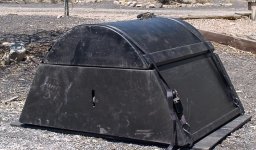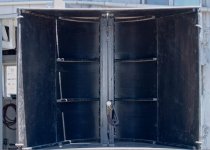I think the key with "wiggle" "bendy" "rubber" plywoods is to use a hard curing PVA or even exopy adhesive, along with the vacuum press or whatever your choice of clamping during the shaping / curing process. The version of this material sold locally here is generically termed "rubberply", and consists of 2 thick layers of very soft Meranti veneer over a central core of flexible (probably synthetic?) rubber. The photo that Dave posted earlier was actually 3 layers of 5.2mm thick rubber ply shaped in vacuum bag, with Dural yellow glue
The face veneers on the rubber ply are very soft ( can be dented with your fingernail) and rough, so at least one layer of something like 1/8" MDF or veneer ply are advisable - I found contact cement to be fine for that .
Note that for larger shapes such as this, the vacuum bag forms need to be very sturdy - at full vacuum, the pressure of approx 15psi at sea level works out to over a ton per square foot, and the thinner or softer veneers you're trying to shape will easily buckle if not well supported.
The face veneers on the rubber ply are very soft ( can be dented with your fingernail) and rough, so at least one layer of something like 1/8" MDF or veneer ply are advisable - I found contact cement to be fine for that .
Note that for larger shapes such as this, the vacuum bag forms need to be very sturdy - at full vacuum, the pressure of approx 15psi at sea level works out to over a ton per square foot, and the thinner or softer veneers you're trying to shape will easily buckle if not well supported.
Check this out on Youtube.
https://youtu.be/g0ikg9NdUvM
Shows a way to bend normal plywood.
Flexible plywood is intriguing but I wonder what's the effect in stiffness and transient performance.
It's certainly stiff, once you have a few layer glued up in a vacuum press it's no less stuff than any other ply, especially if you are using the exterior grade stuff
Hi all. Pano, yes, I just successfully laminated 6 X 4mm curved hardboard (eg masonite) panels (3 panels for each box) for the rear of my enclosures (~870 x 550mm panels, ~500mm radius).
Used Titebond 2 between laminates, screws to center the boards, rachet straps and wood to bend panels, and the speaker box skeleton as the form.
Was reluctant to go the bending ply root due to its high cost and sponginess (ie low elastic modulus). I guess it still may be okay if used as a core panel and laminated with something more rigid (similar to what chrisb has done).
Hi @chrisb - I'm assuming you are the same Chris that makes Planet10 enclosures? Can you tell us, what is the final thickness of the finished composite panel that Dave posted earlier and how it compares mechanically and acoustically to other panel constructions that you have made in the past?
Used Titebond 2 between laminates, screws to center the boards, rachet straps and wood to bend panels, and the speaker box skeleton as the form.
Was reluctant to go the bending ply root due to its high cost and sponginess (ie low elastic modulus). I guess it still may be okay if used as a core panel and laminated with something more rigid (similar to what chrisb has done).
Hi @chrisb - I'm assuming you are the same Chris that makes Planet10 enclosures? Can you tell us, what is the final thickness of the finished composite panel that Dave posted earlier and how it compares mechanically and acoustically to other panel constructions that you have made in the past?
mrk7 - "guilty" I guess - the finished thickness on the Elipse enclosures Dave posted would have been just under 19mm before veneer. The section of the front panel in which the drivers were installed was 18mm BB ply, and the entire shell was supported by an interlocking spar and rib assembly, rather like an airplane wing. After several PC crashes and a particularly nasty virus infection, I've not been able to find the few assembly photos of the build.
It'd be hard for me to make an assessment of comparison of that particular composition vis a vis my standard technique of 15 or 18mm "Baltic Birch" plywood, as I reserve the former strictly for curved assemblies. Dave had originally proposed that design with a series of beveled flat strips - altogether feasible I guess, but I wanted to try this - it's a technique we frequently use for curved bulkheads and panels in commercial millwork. With several layers and modified PVA yellow glue, you can fabricate a pretty sturdy panel. Some might even want to theorize that some degree of constrained layer damping would be achieved by the multiple layers of material of different densities.
It'd be hard for me to make an assessment of comparison of that particular composition vis a vis my standard technique of 15 or 18mm "Baltic Birch" plywood, as I reserve the former strictly for curved assemblies. Dave had originally proposed that design with a series of beveled flat strips - altogether feasible I guess, but I wanted to try this - it's a technique we frequently use for curved bulkheads and panels in commercial millwork. With several layers and modified PVA yellow glue, you can fabricate a pretty sturdy panel. Some might even want to theorize that some degree of constrained layer damping would be achieved by the multiple layers of material of different densities.
chrisb - cheers for the info. Sorry to hear your PC is misbehaving. Would definitely have loved to see the construction pics. The cabs look really classy.
Pano - You're welcome. The laminated masonite panels are quite rigid (resist buckling and deflection no worries). I don't have any quauntitative data but can also say that by ear they produce a similar high pitched tone to that of the 12mm (9ply) Maple plywood that I am also using.
Pano - You're welcome. The laminated masonite panels are quite rigid (resist buckling and deflection no worries). I don't have any quauntitative data but can also say that by ear they produce a similar high pitched tone to that of the 12mm (9ply) Maple plywood that I am also using.
Any ideas on developing a "good enough" vacuum for gluing?
Something cheap and easy using readily available second hand parts. eg, the compressor from a fridge any good?
I've rigged a cheap auto parts store tire pump to suck instead of blow. You don't need a hard vacuum. 14 of the 14.7 available psi gets you almost everything you're looking for. Some sort of vacuum gauge is handy to show what's actually going on. The tricky part is obtaining a bag with no leaks, as minor leaks can make it not work very well even with a very big and expensive pump. I was working with cement hardboard and used an in-line fuel filter to keep any crumbs from getting sucked into the pump cylinder. Anyway, this is certainly part of the lamination process that can be seriously hacked.
Last edited:
Pano,I was at the Home Depot last night looking at hardboard, you know, the stuff they make into pegboard, and wondering how well it would bend and laminate. Anyone tried it?
Using basically the same approach as Mrk7 described in post #25 I also have laminated two pieces of 1/8" tempered hardboard for the Hyperboline hyperbolic curve:
https://soundforums.net/threads/7268-HyperboLine-%99-new-Player-in-the-Old-Game#post
The bent hardboard really makes for a stiff enclosure, and is pretty easy to get a consistent paint job, as there is no grain to hide.
Art
Attachments
- Status
- This old topic is closed. If you want to reopen this topic, contact a moderator using the "Report Post" button.
- Home
- Loudspeakers
- Multi-Way
- bending plywood


